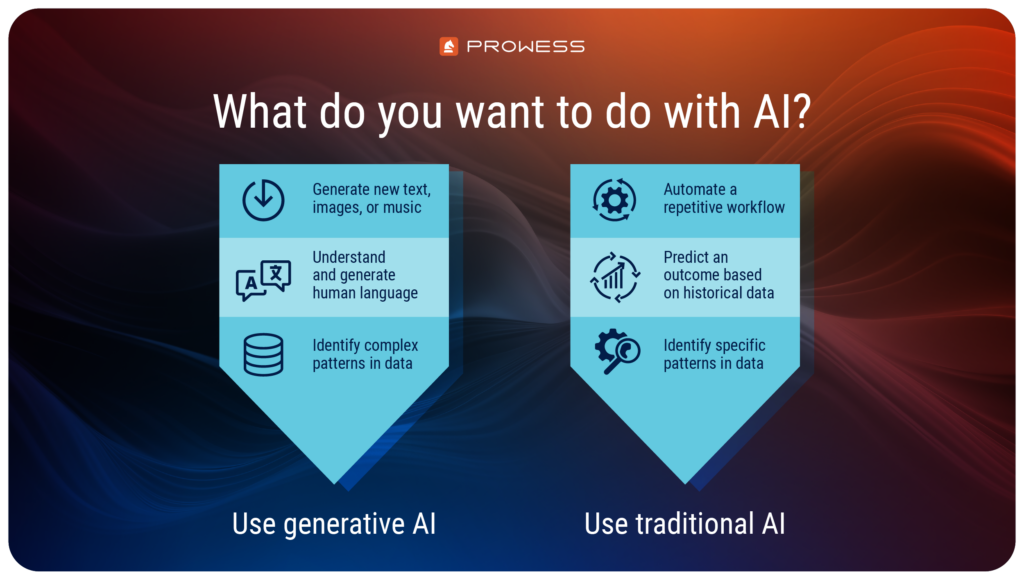Business leaders who understand the different types of AI are better able to harness its potential to drive innovation and efficiency. Let’s review the differences between traditional AI and generative AI and the types of uses for which each of them is best suited.
Traditional AI
Scientists created the first AI solutions in the 1940s, using techniques that we now call traditional AI. It works best for well-defined tasks that can be broken into small steps. Traditional AI systems are:
- Rule-based: Traditional AI systems solve problems by using predefined rules and logic statements crafted by human experts and designed to mimic logical reasoning.
- Limited in their ability to learn: Traditional AI systems generally cannot learn from new data or adapt their behavior over time. Any updates or improvements to the system require manual intervention and reprogramming.
- Good with structured data: These systems work best with structured data, where the relationships and rules can be clearly defined. They struggle with unstructured data like images, natural language, and complex, dynamic environments.
Traditional AI is popular across a wide range of industries. For example, Netflix uses traditional AI techniques as part of its broader strategy to provide personalized film recommendations. These techniques include collaborative filtering, which recommends films to a user based on similar users’ preferences or what the user has liked, and content filtering, in which the system recommends films with genres, directors, or actors the user has previously liked. PayPal employs a traditional AI system with defined rules to identify and prevent fraudulent transactions. And Facebook combines rule-based systems and traditional machine learning (ML) to detect and remove inappropriate content from its site.
Generative AI
Generative AI, on the other hand, entails AI systems that are capable of creating new content, such as text, images, music, or code, by learning patterns from existing data. In the 1980s, the foundation for generative AI was set by introducing neural networks and early ML models. Neural networks are computational models inspired by the human brain, while ML models use algorithms that learn from data. Several trends made ML practical:
- More data was becoming available in digital form.
- Generative AI problems could be framed as pattern recognition problems.
- More powerful microprocessors became available.
Figure 1 provides an overview of how generative AI works. First, a model is chosen. Then, a large set of data is used to train it. Once the model is trained, it’s deployed to production. New data is then applied to the model, using AI inferencing to generate outputs, such as text, images, audio, video, or code.

Figure 1. The generative AI process
In 2022, OpenAI launched Chat Generative Pre-trained Transformer, or ChatGPT, which is an advanced conversational AI model—or “chatbot.” Since then, the adoption of generative AI has exploded. Organizations harness it for content creation, product design, customer support, and more. According to the McKinsey Global Institute, generative AI will add between $2.6 and $4.4 trillion annually to the global economy, increasing AI’s economic impact by 15–40%.1
The use of generative AI has skyrocketed in the past few years for three reasons: (1) the recent development of more advanced deep learning (DL) architectures and models, (2) the advent of more powerful computing infrastructures, and (3) the availability of more data for training. The evolution of new DL architectures and models in the past decade, including generative adversarial networks (GANs), transformers, and large language models (LLMs), has unlocked new possibilities and applications. The emergence of more powerful hardware accelerators, such as graphics processing units (GPUs) and Tensor Processing Units (TPUs), supports the immense computational demands of training and running DL models. Finally, new and diverse datasets can train models, including Common Crawl, Common Objects in Context (COCO), and LibriSpeech.
Follow the Rules or Create New Content?
Traditional AI excels at specific tasks with defined rules and explicit programming, while generative AI applies pattern recognition to learn from data and create new content. Table 1 summarizes the differences between the two.

Table 1. Traditional AI versus generative AI
Traditional AI systems are like specialized tools, finely tuned for particular jobs, while generative AI systems are more like Swiss Army knives, capable of performing various tasks. Each type of AI can help drive innovation and efficiency in the right application, as shown in Figure 2.

Figure 2. Traditional AI and generative AI excel at different types of tasks
Business leaders who understand the differences between traditional AI and generative AI can make more informed strategic decisions, improve customer engagement, and optimize costs. With this comprehensive understanding, they can harness the full potential of AI technologies to achieve their business objectives.
Learn More
Read more about AI in the following Prowess Consulting articles and reports:
- Navigating AI for Business with Expert Guidance from Prowess
- AI Vs. Machine Learning Vs. Deep Learning
- Built-In Intel AI Accelerators and Why You Should Use Them
Prowess advises clients on a variety of AI ambitions and projects. Contact us to explore how we can help your organization benefit from AI.
__________________________________________________________
1 Databricks. MIT Technology Review Insights. “MIT CIO Generative AI Report.”
Related Posts

Agentic AI: How to Harness Speed Without Losing Control
Speed gives agentic AI power—and risk. With the right strategy, it becomes a fast, trustworthy driver of ROI.

The Agentic Divide: Don’t Get Left Behind
Agentic AI is creating a widening gap between leaders and laggards. Learn why conviction—not experimentation—defines who gets ahead.

Eliminate Bottlenecks, Achieve Exponential Throughput, and Future-Proof Your Operating Model with Agentic AI
Agentic AI eliminates bottlenecks, drives exponential throughput, and transforms enterprise operations through governed, autonomous systems of action.
